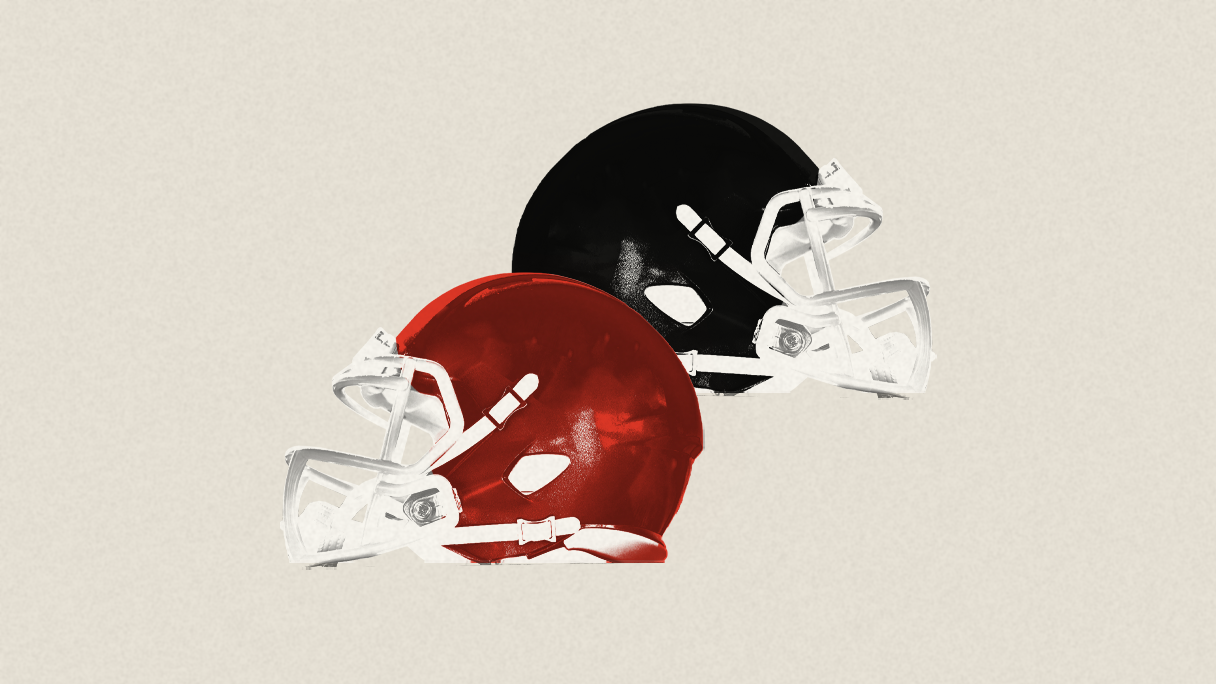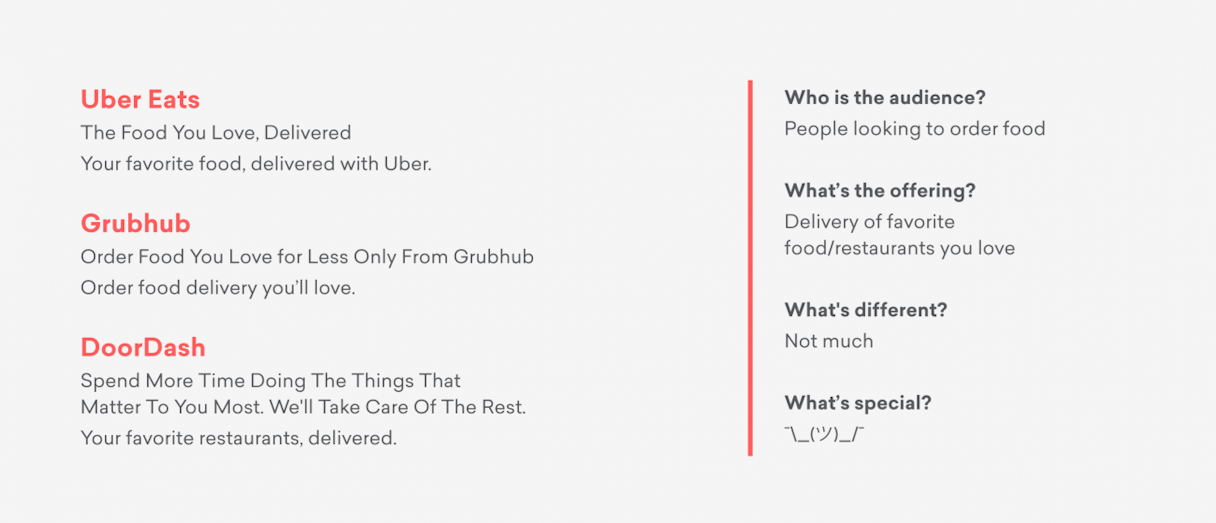Verbal Identity
The Truth About Positioning and Messaging

Occasionally, a Chili Cook Off inspires reflection into brand messaging and positioning. This is one of those times. Are they the same thing? Can I skip one? No and no.
One football Sunday, at a Chili Cook Off party, someone made an outrageous claim as we gathered around the stove, where there were two types of chilis simmering: All food delivery services are equal. Grubhub, DoorDash, Uber Eats, Bite Squad, Postmates. Equal. Identical. Indistinguishable.
“Same difference,” he shrugged, as if that were the end of it, then carefully ladled the vegetarian chili (red lentils, corn, maple syrup) into his bowl. Not so much as a glance at the classic variety. His position was clear, on both food delivery and chili.
Now, say something like this to a crowd of hungry sports enthusiasts, poised for friendly competition, and it's most definitely not the end of it. Over the steam of the competing chilis floated a hot mess of rebuttals, each more unequivocal than the last:
- No man, Uber Eats is way faster than everyone else
- Grubhub doesn't even have a tracking map
- There’s just not a lot of great restaurant options from them, aside from Uber Eats
- DoorDash is just fast food stuff and if I'm paying to have my food delivered, it better be an event
- At least Grubhub tries to save you money
- DoorDash’s drivers are so much better there's literally no comparison
On it went. Vegetarian Chili, unfazed, bit into some cornbread. “I don't really see a difference.”
A few things were true: We all used food delivery services. We had all tried more than one. We were all selecting from the same market options, given our geographic similarity. And we were all in the same audience segment: Gen Xers, parents, foodies. And yet, how we perceived the food delivery services available to us was all over the map. We couldn’t agree that they were equal (except Vegetarian Chili), but we couldn’t agree on what made them different (i.e. better) either.
To complicate things, what we valued from the service was also at odds. Speed vs. fancier restaurants vs. perks vs. existing brand loyalty vs. healthy options vs. better app features. And this chaos was reflected in what we said about our favorite services (and our least) to our friends, over chili. In that moment, we became brand advocates, telegraphing what we believed made our preferred delivery service better than the others. Whether that accurately reflected the brand’s real position or not.
Which brings us to the difference between positioning and messaging. And, unlike the vagaries of food delivery, this difference is not up for debate.
First, a definition or two.
Brand positioning is the process of intentionally defining what your brand will be known for and by whom. It's about giving organizations a place in the market where they can make stronger, authentic connections with the right customers, partners, and communities. By carving out your stance against alternatives, you can make your value easy to understand, consistent, and impossible to miss.
Through brand positioning, we guide audiences to the singular experience that is us.
Yes, it’s about how we wish to be perceived. But more than that, it’s an honest accounting of how we can be perceived, based on deep and intimate knowledge of who we are, what we offer, how we offer it, and to whom. Brand positioning considers everything from competitive alternatives to best-fit customers to our brand promise to our products, technologies, and culture. This level of insight requires real discovery work, which tracks along with brand strategy. All so we can simply differentiate Grubhub from Bite Squad for our audience. This is positioning.
But ideally, our position does far more work for us than just differentiate. It conjures up all the right associations and context for our audience, creating a connection that generates brand loyalty. It begins to communicate our essence, our ethos, our red lentil magic.
The other thing it does is immediately give focus to every communication or marketing effort that follows. Once we have our undeniable position in place, we look closely and discover, encoded within it, a strategy. A good position cracks open a brand to reveal where its messaging should go. Now we can rally around the positioning in our messaging, bringing attention to it, reinforcing it.
Brand positioning is an internal process, an exercise, and an internal directive. As for messaging? It’s anything but internal.
Now onto messaging.
Messaging is the external-facing expression of our position. It gives positioning a public face. It's the manifestation of all that internal work, something we intend to be seen by our audience in the form of taglines, site copy, promotional materials, and so on.
Positioning is how we’ve decided to be perceived; messaging drives that perception home.
While it's true that positioning can have other outcomes like helping to inform business strategy, that's not an absolute. And since positions can adapt as the market (or the brand) changes, they aren't some intractable thing that impedes or limits a brand’s progress either. (Things shift. Your positioning can, too.) But adopting a solid position and working from it is an invaluable part of what brand writers, strategists, and designers need in crafting identity. It gives energy and direction to their process, especially when it comes to messaging.
What happens if you don't invest in that process? If you don’t assume a position? Well, your audience will do it for you. Which brings us back to food delivery service.
Listen, you can’t fail to have a position. Your audience, as a species, is too imaginative for that. Not to mention, we must give order to the influx of information and messaging we’re constantly receiving. So rest assured, everybody from Vegetarian Chili to the guy on the couch three yards away from the conversation has assigned your brand a position in their heads, if you haven’t done it for them. A brand without a claimed position isn’t a ship without a sail, it’s a ship without a rudder.
Since we know that positions are internal directives, the only way we can compare positions between competitors is to look at their outward expression, or messaging. Let's take a look at a few taglines and lead statements of those food delivery services.

Uber Eats stresses, “It’s Uber, you know us.” Grubhub claims they’ll save you money. DoorDash says, “We’ll save you time.” Working backward from this messaging, we can assume that the positioning for Uber Eats, Grubhub, and DoorDash point out these differences. But is there anything else that separates them, according to the messaging? Is there a true separation, when convenience is the shared, and espoused, value? Not really. They’ve left the job of what truly distinguishes them to their audience. That audience imputes the real and valued differences, because the messaging fails to carry the full position forward. Which is a signal that the positioning is likely ill-defined in the first place.
Positioning via messaging should be perceptible.
Your audience should subtly detect it, accept it, incorporate it into what they understand about you, and then repeat it over chili, before halftime. Even though you can't force anybody to see, think, or feel a certain way about your brand, you can sure try.
The path to identity, advocacy, and loyalty starts with a solid position. Messaging gets you the touchdown.

